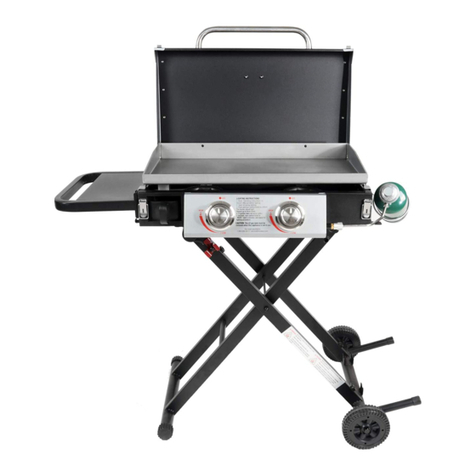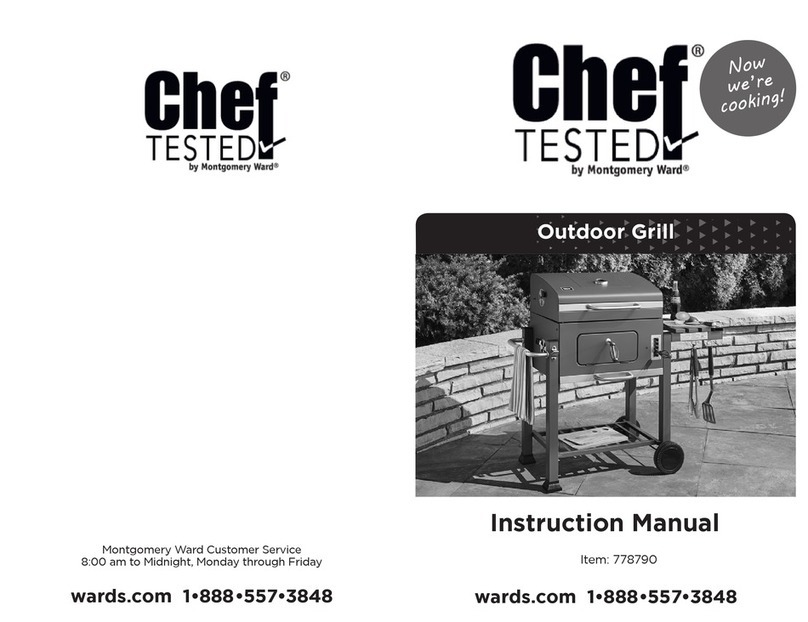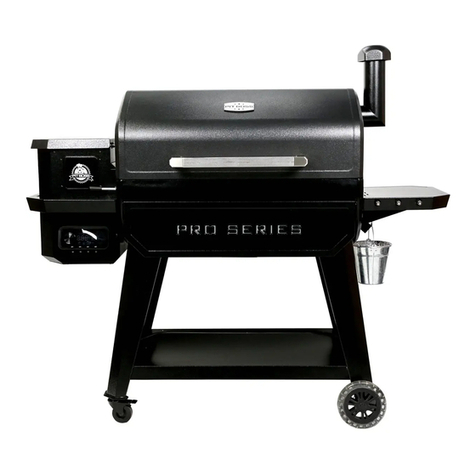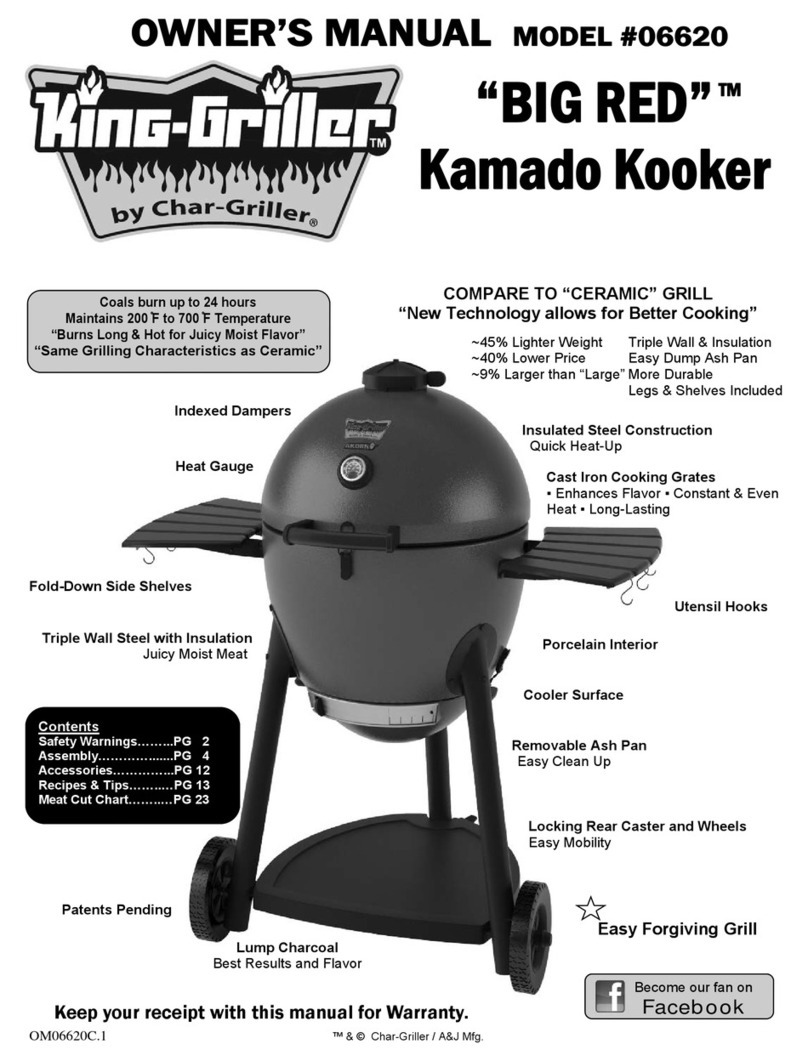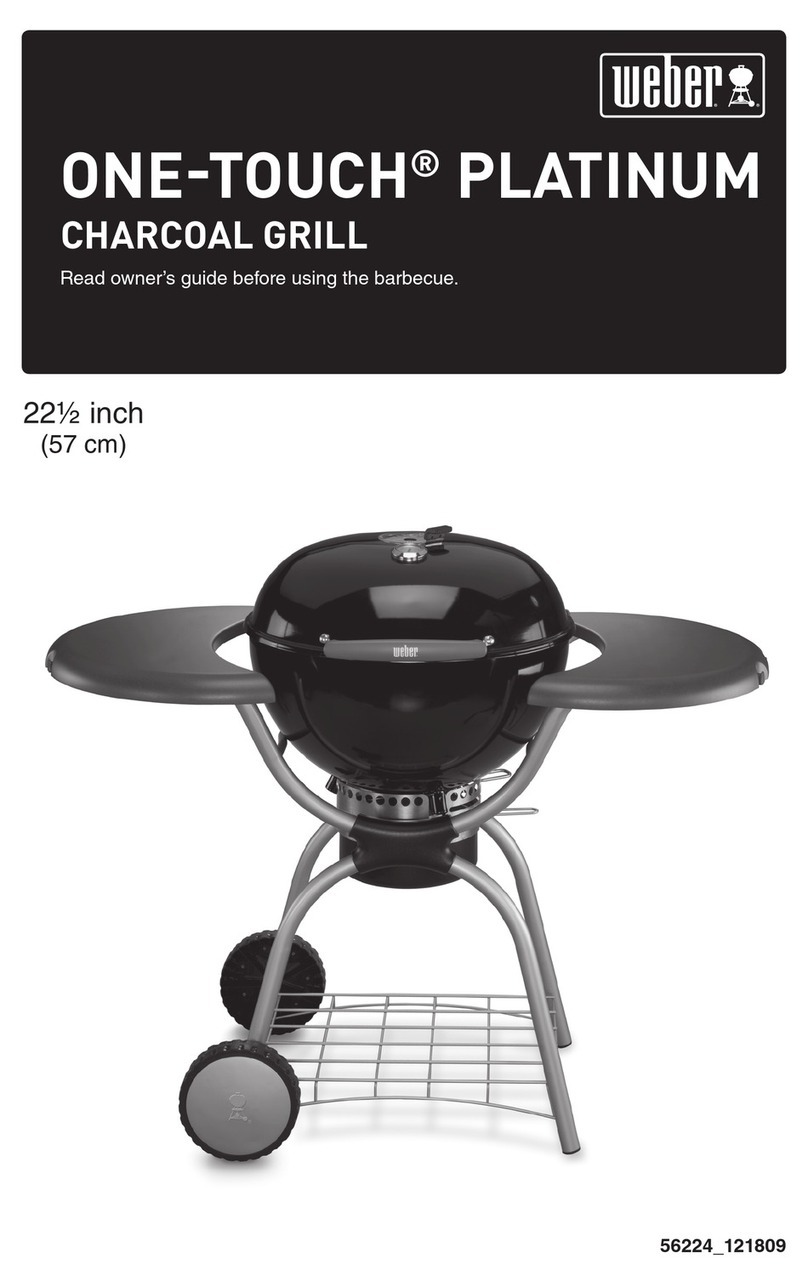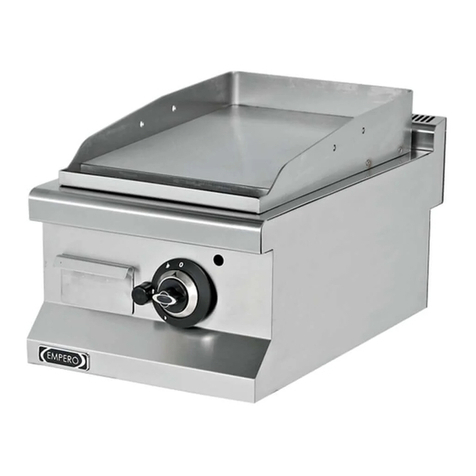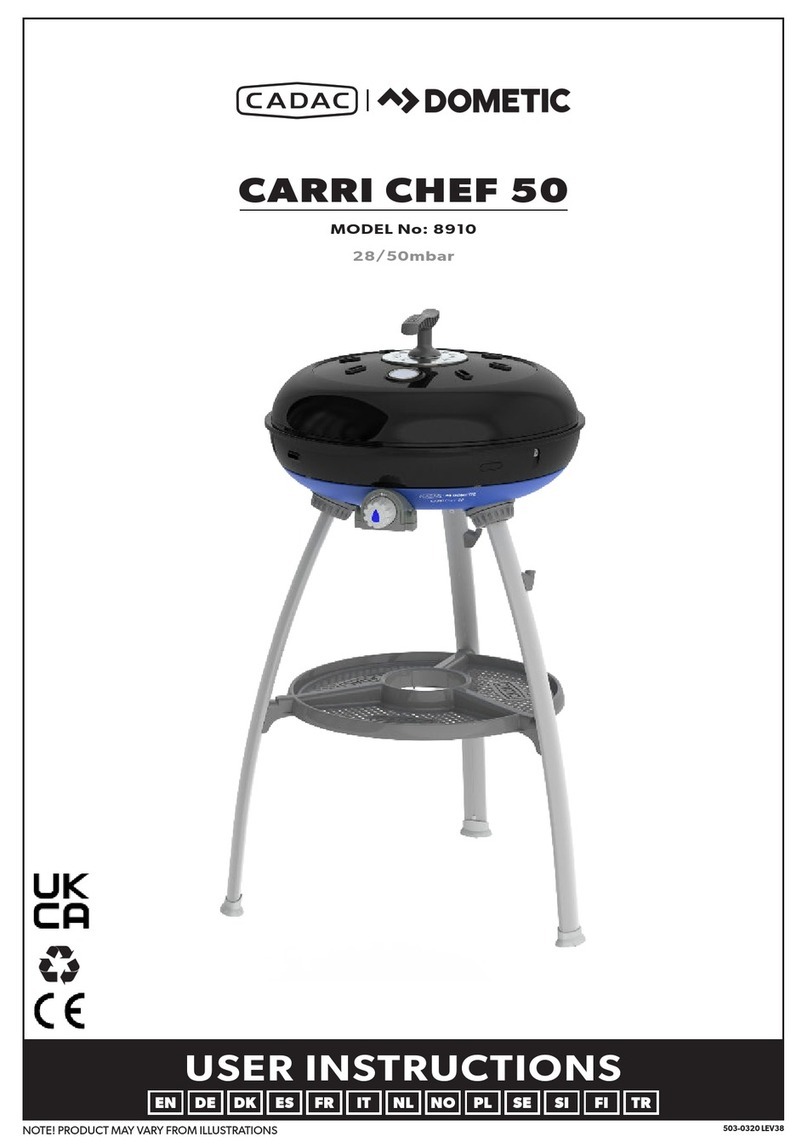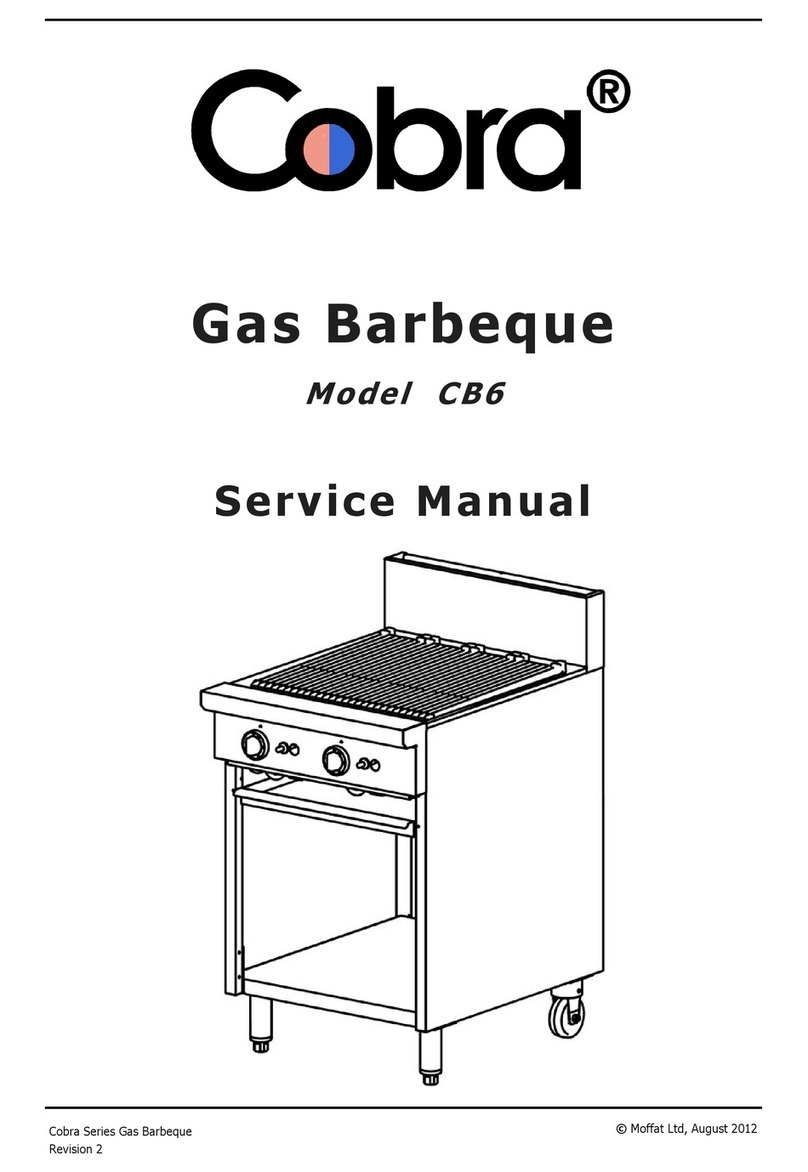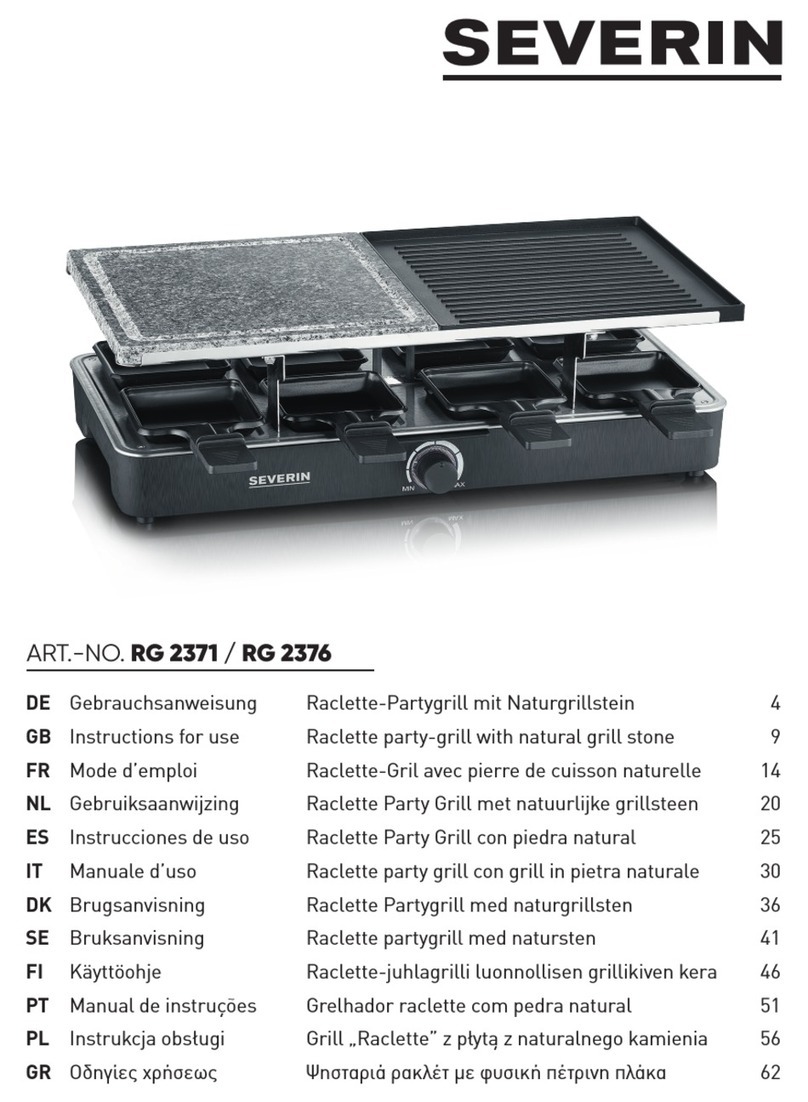Vulcan-Hart Vulcan VCCB25 User manual

VULCAN-HART COMPANY, P.O. BOX 696, LOUISVILLE, KY 40201-0696, TEL. (502) 778-2791
FORM 30952 (1-96)
VCCB COUNTERTOP CHAR-BROILER
MODEL NO.
VCCB25 ML-114540
VCCB30 ML-114541
VCCB36 ML-114542
VCCB47 ML-114543
VCCB60 ML-114544
VCCB72 ML-114545
VCCB84 ML-114546
SERVICE MANUAL
MODEL VCCB36

— 2 —
IMPORTANT FOR YOUR SAFETY
THIS MANUAL HAS BEEN PREPARED FOR PERSONNEL QUALIFIED TO INSTALL GAS
EQUIPMENT, WHO SHOULD PERFORM THE INITIAL FIELD START-UP AND
ADJUSTMENTS OF THE EQUIPMENT COVERED BY THIS MANUAL.
POST IN A PROMINENT LOCATION THE INSTRUCTIONS TO BE FOLLOWED IN THE
EVENT THE SMELL OF GAS IS DETECTED. THIS INFORMATION CAN BE OBTAINED
FROM THE LOCAL GAS SUPPLIER.
IMPORTANT
IN THE EVENT A GAS ODOR IS DETECTED, SHUT
DOWN UNITS AT MAIN SHUT-OFF VALVE AND
CONTACT THE LOCAL GAS COMPANY OR GAS
SUPPLIER FOR SERVICE.
FOR YOUR SAFETY
DO NOT STORE OR USE GASOLINE OR OTHER
FLAMMABLE VAPORS OR LIQUIDS IN THE
VICINITY OF THIS OR ANY OTHER APPLIANCE.
WARNING
IMPROPER INSTALLATION, ADJUSTMENT,
ALTERATION, SERVICE OR MAINTENANCE CAN
CAUSE PROPERTY DAMAGE, INJURY OR DEATH.
READ THE INSTALLATION, OPERATING AND
MAINTENANCE INSTRUCTIONS THOROUGHLY
BEFORE INSTALLING OR SERVICING THIS
EQUIPMENT.
IN THE EVENT OF A POWER FAILURE, DO NOT
ATTEMPT TO OPERATE THIS DEVICE.

— 3 —
TABLE OF CONTENTS
Important safety information page 2
Codes and standards information page 3
Clearance information page 3
Manual use information page 3
Data plate information page 3
Tools required for servicing page 3
General appliance information page 4
Section l Service Checks and Adjustments page 5-8
Section ll Removal of Service Parts page 9-18
Section lll Troubleshooting page 19
CODES AND STANDARDS
Vulcan-Hart Charbroilers are to be installed in accordance with state and local codes, or in the absence of local
codes, with the National Fuel Gas Code, ANSI-Z223.1 (latest edition), available from the American Gas
Association, Inc., 1515 Wilson Blvd., Arlington, Va. 22209 and with ANSI-NFPA Standard #96 (latest edition),
Vapor Removal From Cooking Equipment, available from the National Fire Protection Association, Batterymarch
Park, Quincy, MA 02269.
CLEARANCES
COMBUSTIBLE NON-COMBUSTIBLE
CONSTRUCTION CONSTRUCTION
BACK Above Grid Level 12" 0"
Below Grid Level 3" 0"
SIDES Above Grid Level 9" 0"
Below Grid Level 3" 0"
HOW TO USE THIS MANUAL
This manual is dedicated to the servicing of the Vulcan-Hart Co. VCCB Countertop Char-Broiler.
The manual is divided into 3 sections, CHECKS AND ADJUSTMENTS, REMOVAL OF SERVICE PARTS AND
TROUBLESHOOTING. For additional technical assistance refer to the service assistance number on the front
cover of this manual. Refer to parts manual to identify service replacement parts.
DATA PLATE
The data plate which identifies the appliance model no., device no., serial no., gas specification, clearances and
agency approvals is located on the lower right body side of the appliance.
TOOLS REQUIRED
Tools required to preform the service operations covered in this manual.
1. Standard set of hand tools.
2. 1/2" Deep throat socket.
3. Offset flat blade screwdriver.
2. Temperature tester (thermocouple or digital pyrometer).
4. Gas test kit.

— 4 —
GENERAL APPLIANCE INFORMATION
VCCB25 is a 25" wide Char-Broiler with 4 burners rated at 14,500 BTU's ea.
VCCB30 is a 30" wide Char-Broiler with 5 burners rated at 14,500 BTU's ea.
VCCE36 is a 36" wide Char-Broiler with 6 burners rated at 14,500 BTU's ea.
VCCB47 is a 47" wide Char-Broiler with 8 burners rated at 14,500 BTU's ea.
VCCB60 is a 60" wide Char-Broiler with 11 burners rated at 14,500 BTU's ea.
VCCB72 is a 72" wide Char-Broiler with 13 burners rated at 14,500 BTU's ea.
VCCB84 is a 84" wide Char-Broiler with 16 burners rated at 14,500 BTU's ea.

— 5 —
SECTION I
SERVICE CHECKS AND ADJUSTMENTS
WARNING: SHUT OFF GAS BEFORE SERVICING
VENTILATION CHECKS
Insure that adequate ventilation has been provided in accordance to all codes as stated on page 3 of this manual.
The vent for this appliance should be checked for restrictions every 6 months.
GAS SUPPLY CHECKS
If the gas supply piping is to be tested at a test pressure in excess of 1/2 psig(3.45Kpa), the appliance and its
individual shut-off valve must be disconnected from the supply line. If the gas supply piping system is to be tested
at a pressure equal to or less than 1/2 psig(3.45Kpa), the individual shut-off valve must be closed during testing.
REGULATOR VENT CHECK
1. With a screwdriver pry the plastic vent plug from the top of the regulator. (See Fig. 1)
2. Check vent for clogging of the breather vent screen. If screen is obstructed, clear the obstruction.
STORE LINE GAS PRESSURE CHECK
1. Turn main gas line off.
2. Tap the store line ahead of the pressure regulator if a gas pressure tap and plug have not been supplied.
3. Install a single pilot valve fitting or similar device that will allow a gas pressure gauge to be connected to
the store line.
4. Connect the gas pressure gauge to the tapped valve device.
5. Turn the store main gas on.
6. Turn the unit gas on.
7. Take the store pressure reading. Store pressure should be at least 6" W.C. for natural gas and 11" W.C.
for propane gas.
8. If store pressure is not correct advise owner that the gas line pressure must be serviced for proper gas flow
before appliance service can be preformed.
9. If store pressure is correct, continue checking by performing the appliance gas line check.
APPLIANCE GAS LINE CHECK
1. Turn appliance gas off.
2. Remove the burner knobs.
3. With a phillips head screwdriver remove (4) screws securing the front cover to the broiler.
4. From the front right side of the appliance follow the gas pipe to the gas line pressure tap.
5. Connect the gas meter to the line pressure tap.
6. Reinstall the burner knob handle and turn the appliance gas on.
7. Check the appliance pressure. Reading should be 5" W.C. for natural gas and 10" W.C. for propane gas.
PILOT CHECK
1. Follow steps 1-3 under Removal of Pilot Tubing.
2. With a 7/16" wrench remove the pilot from the pilot tube.
3. Examine the pilot and the tube for blockage.
4. If blockage is found, remove it using air or water pressure.
5. If blockage cannot be removed, replace the pilot.
6. Reinstall or replace pilot by reversing steps 1-2 above.

— 6 —
BURNER NOZZLE ORIFICE CHECK
Perform this procedure only after the pilot has been checked and the pilot valve has been adjusted.
1. Follow steps 1-2 under Removal of Front Cover.
2. Follow steps 1-2 under Removal of Top Grates.
3. Follow steps 1-5 under Removal of Radiants.
4. Follow steps 3-5 under Removal of Burner/Deflector Assembly.
5. With a 1/2" deep throat socket remove the burner nozzle from the burner valve. (See Fig. 15)
4. Inspect the nozzle for blockage.
5. If blockage is found, loosen the hood compression nut and remove the hood.
6. Clear blockage by blowing compressed air or water through the hood orifice opening.
7. Reinstall or replace the burner nozzle by reversing steps 1-5 above.
REGULATOR ADJUSTMENT
1. Follow steps 1-2 under Regulator Vent Check.
2. Follow steps 1-9 under Store line Gas Pressure Check and steps 1-7 under Appliance Gas Line Check.
3. If store pressure checks out but the appliance pressure is not correct, with a flat blade screwdriver remove
the regulator adjustment closure cap. (Fig. 1)
Fig. 1
4. With a flat blade screwdriver, while still connected to the pressure gauge, rotate the regulator adjustment
screw clockwise to increase pressure and counterclockwise to decrease pressure. Appliance pressure
should be 5" W.C. for natural gas and 10" W.C. for propane gas. Adjust the regulator to obtain the required
reading.
PILOT VALVE ADJUSTMENT
1. Follow lighting instructions if pilot is not already lit.
2. Follow steps 1-2 under Removal of Front Cover.
3. Remove the top grates so that the pilot flame can be clearly seen.
VENT PLUG ADJUSTMENT CAP

— 7 —
4. With a flat blade screwdriver, turn the pilot adjustment screw counterclockwise to increase gas flow and
clockwise to decrease gas flow. (Figs. 2)
NOTE: Steps 2 and 3 may be optional as adjustment can be made using the access holes provided in the front
control panel cover.
Figs. 2

— 8 —
BURNER VENTURI AIR SHUTTER ADJUSTMENT:
1. Follow steps 1-2 under Removal of Front Cover.
2. Using an offset flat blade screwdriver loosen the air shutter adjustment screw. (Fig. 3)
3. Turn the burner ON valve on.
4. With a pair of pliers rotate the air shutter so that a blue flame without any yellow tipping is seen across the
burner.
5. Once the proper adjustment is made carefully tighten the adjustment screw without moving the air adjuster.
6. Reassemble front cover when adjustment is complete.
Fig. 3
AIR SHUTTER ADJUSTMENT SCREW

— 9 —
SECTION II
REMOVAL OF SERVICE PARTS
WARNING: SHUT OFF GAS BEFORE SERVICING.
REMOVAL OF FRONT COVER
1. With a small blade screwdriver, loosen the mounting screw in each top burner knob. (Fig. 4)
Fig. 4
2. Pull the knobs from the appliance.
3. With a phillips head screwdriver, remove (4) #8 screws that secure the front cover to the appliance body
frame. (Fig. 5)
Fig. 5

— 10 —
4. Remove the cover.
5. Reinstall the covering by reversing steps 1-4.
REMOVAL OF TOP GRATES:
1. Allow grates to cool.
2. Lift the front of the grate up then remove the back end of the grate from the burner box ledge.
(Fig. 6)
Fig. 6
3. Reinstall by reversing steps 1-2.

— 11 —
REMOVAL OF RADIANTS:
1. Allow top sections to cool.
2. Follow steps 1-2 under Removal of Top Grates.
3. Slide the radiant towards the rear of the broiler to clear the gutter insert channel.
4. Lift the front end of the radiant up. (Fig. 7)
Fig. 7
5. Lift the radiant back end up off of the radiant support. (Fig. 7)
6. Reinstall the radiant by reversing steps 1-5.

— 12 —
REMOVAL OF THE DEFLECTOR FROM THE BURNER DEFLECTOR ASSEMBLY:
1. Follow steps 1-5 under Removal of the Deflector/Burner assembly.
2. With a pair of pliers, straighten the attachment rod at the end towards the burner venturi, until
the rod will slip freely from the assembly. (Fig. 8)
Fig. 8
3. From the burner assembly foot mounting end, pull the attachment rod out freeing the
deflector from the burner.
ROD

— 13 —
REMOVAL OF RADIANT BURNER SUPPORTS:
1. Follow steps 1-5 under Removal of Burner/Deflector Assembly.
2. With a large flat blade screwdriver, remove (2) 1/4-20x1/2"L screws (per burner sections) securing the
support to the back wall of the burner compartment. (Fig. 9)
Fig. 9
3. Reinstall the support by reversing steps 1-2 above.
REMOVAL OF THE PILOT SUPPORT BRACKET:
1. Follow steps 1-5 under Removal of Burner Radiant.
2. With a flat blade screw driver remove (2) #8 screws holding the bracket to the burner box front. (Fig. 10)
3. Snap the pilot hood off of the bracket. (Fig.10)
Fig. 10
4. Reinstall the bracket by reversing steps 1-3.
BRKT
#8 SCREWS

— 14 —
REMOVAL OF BURNER VALVE
1. Follow steps 1-5 under Removal of Burner/Deflector Assembly.
2. With a 6" adjustable wrench follow steps for the Removal of Double Pilot Adapter.
3. With a pipe wrench, disconnect the burner valve from the manifold pipe. (Fig. 11)
Fig. 11
4. If necessary with a 1/2" open end wrench remove the old burner valve hood and install it onto the
replacement valve. (Fig. 11)
5. Reinstall the new burner valve by reversing steps 1-4 above. Use pipe dope on all threaded parts and
test for gas leaks with a soap and water solution before placing the appliance back into service.
HOOD
VALVE

— 15 —
REMOVAL OF DOUBLE PILOT ADAPTER
1. Follow steps 1-3 under Removal of Pilot Adjustment Valve.
2. With a 6" adjustable wrench remove the adapter valve. (Fig. 12)
3. To reinstall adapter reverse steps 1-2.
Fig. 12
REPLACEMENT OF PILOT ADJUSTMENT VALVE
1. Follow steps 1-3 under Removal of Front Cover.
2. Disconnect the compression nut from the pilot tube with a 7/16" wrench. (Fig. 12)
3. With a 6" adjustable wrench, disconnect the pilot adjustment valve from the pilot adapter. (Fig.12)
4. Reinstall the new pilot adjustment valve by reversing steps 1-3. Use pipe dope on all exposed threads before
reassembly and test all connections with a soap and water solution before returning the appliance back into
service.
6. To reinstall burner/deflector follow steps 1-5 in reverse making sure that the burner deflector clears the
burner pilot.
COMPRESSION NUT
PILOT
ADJUSTMENT
VALVE
ADAPTER VALVE
PILOT TUBE

— 16 —
REMOVAL OF BURNER/DEFLECTOR ASSEMBLY
1. Follow steps 1-2 under Removal of Top Grates.
2. Follow steps 2-5 under Removal of Radiant.
3. Lift the back end of the burner assembly up off of the radiant/burner support.
4. Twist the burner/deflector assembly to the right and lower the back down to clear the burner/radiant support
foot. (Fig. 13)
Fig. 13
5. Slide the burner/deflector assembly back towards the rear of the Charbroiler. Raise the back end of the
burner/deflector assembly up slightly and lift the burner venturi from the burner valve hood. (Fig. 14)
Fig. 14

— 17 —
REMOVAL OF BURNER VALVE ORIFICE HOOD:
1. Shut off main gas valve.
2. Follow steps 1-5 under Removal of Burner/Deflector Assembly.
3. With a 1/2" deep throat socket remove the hood. (Fig. 15)
Fig. 15
4. Install new hood by reversing steps 1-3. Be sure to use pipe dope on threaded parts and retest using
a soap and water solution for gas leaks.
REMOVAL OF PILOT TUBING ASSEMBLY:
1. Shut off main gas valve.
2. Follow steps 1-5 under Removal Burner/Deflector Assembly.
3. With a 7/16" open end wrench, loosen the compression nut of pilot adjustment valve that connects the tubing
that is to be removed. (Fig. 12)
4. Snap the pilot/tubing assembly from the pilot holding bracket. (Fig. 14)
5. Remove the tube from the compression nut. (Fig. 12)
6. Install new pilot tube assembly by reversing steps 1-5.
7. Use pipe dope on all exposed threads and test for gas leaks using a soap and water solution before placing
theappliance back into service.
HOOD

— 18 —
REMOVAL OF GAS REGULATOR:
1. Shut off main gas supply valve.
2. With a pipe wrench disconnect the main gas line.
3. With a pipe wrench disconnect the regulator from the appliance inlet pipe.
4. Install the new regulator by reversing steps 1-3.
NOTE: The regulator must be installed in the upper right position with the arrow pointing towards
the appliance. (The arrow is on the underside of the regulator). (Figs. 16)
Use pipe dope on all threaded connection points and test all connection for gas leakage
using a soap and water solution.
Figs. 16

— 19 —
SECTION lll
TROUBLESHOOTING
Uneven heating, sides burning A) Temperature too low.
B) Improper operation of broiler.
C) Fluctuating gas pressure.
Too much top heat A) Temperature too high.
B) Faulty ventilation.
C) Excessive heat input.
D) Overrated (pressure too high or orifice too large.
.
Uneven heat side to side A) Appliance not level side to side.
B) Burner is improperly installed.
Uneven heat front to back A) Appliance not level front to back.
Dried out products A) Broiling time is too long or product is too close
to the burner.
B) Over rated (gas pressure too high or orifice is
too large).
Pilot outage A) Pilot flame is too low.
B) Restriction in pilot orifice.
Poor ignition A) Insufficient gas input.
B) Poor air to gas adjustment.
C) Restriction in pilot orifice.
D) Restriction in main burner ignition port.
E) Pilot adjustment is incorrect.
Other manuals for Vulcan VCCB25
1
This manual suits for next models
6
Table of contents
Other Vulcan-Hart Grill manuals
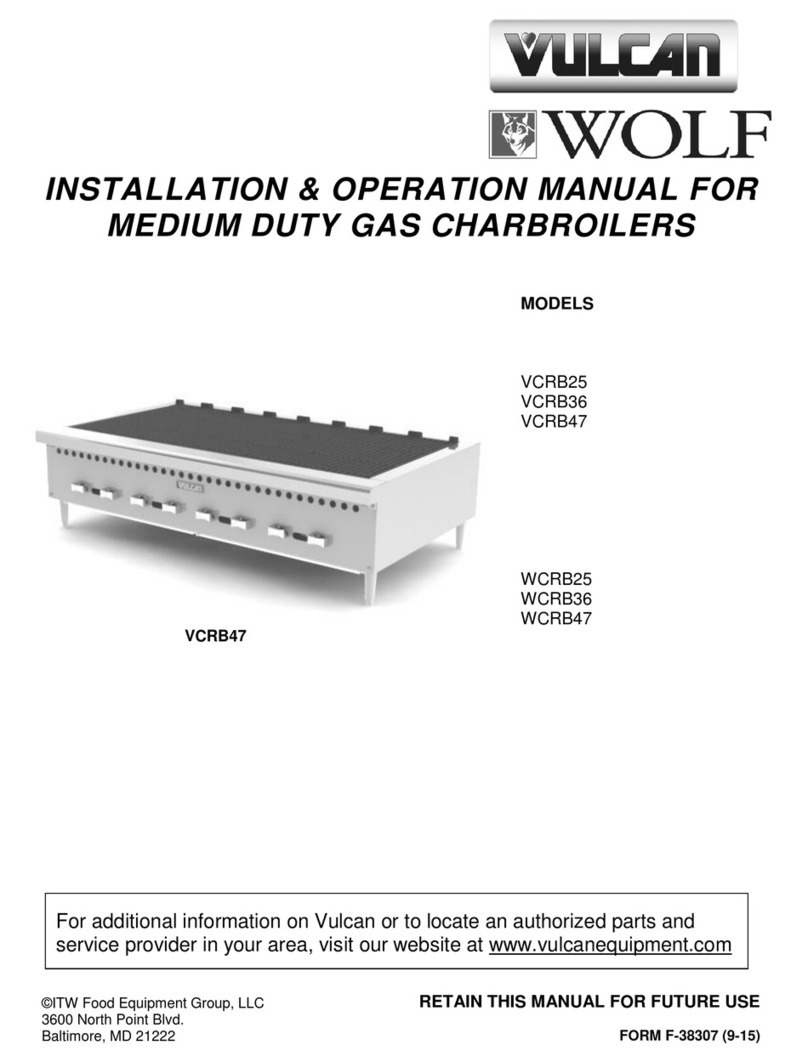
Vulcan-Hart
Vulcan-Hart Wolf VCRB25 User manual

Vulcan-Hart
Vulcan-Hart VACB25 User manual

Vulcan-Hart
Vulcan-Hart MG24CB User manual
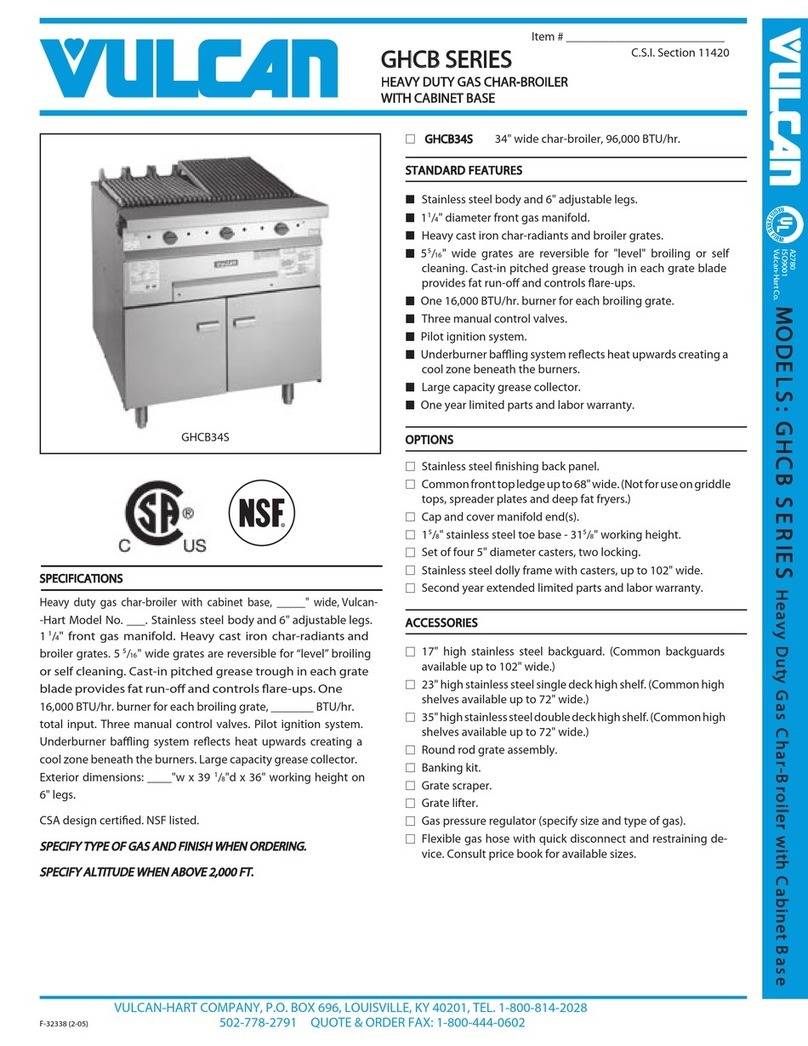
Vulcan-Hart
Vulcan-Hart GHCB34S User manual
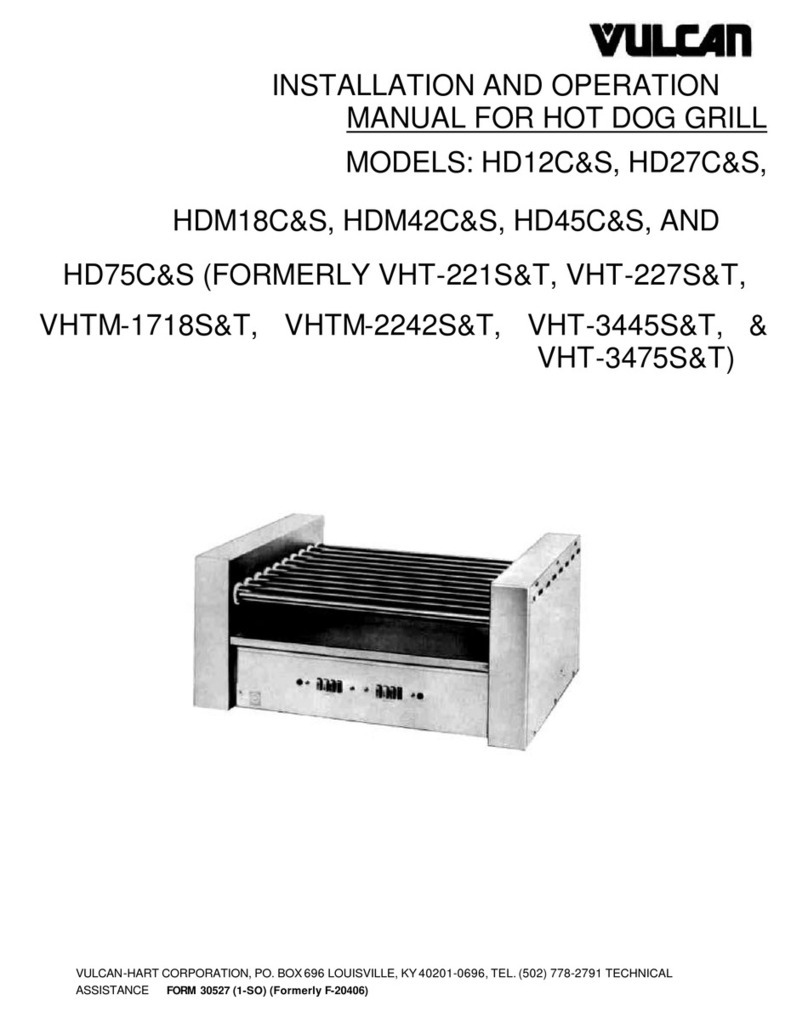
Vulcan-Hart
Vulcan-Hart HD12C Programming manual
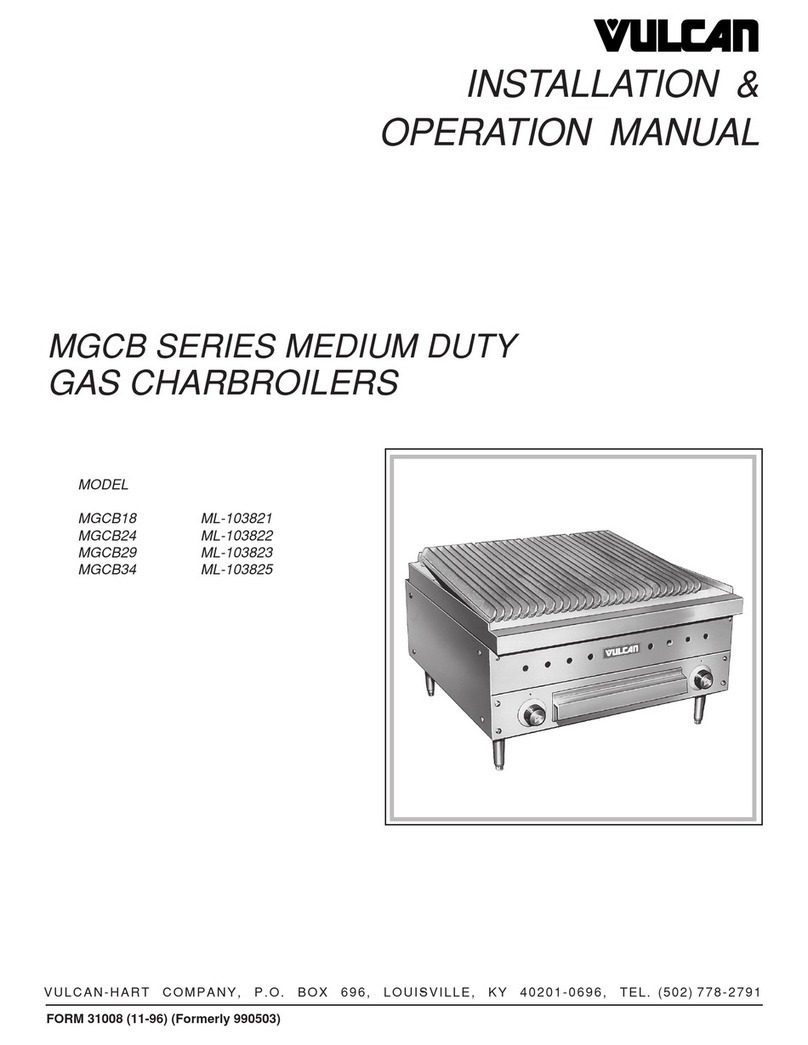
Vulcan-Hart
Vulcan-Hart MGCB18 ML-103821 User manual
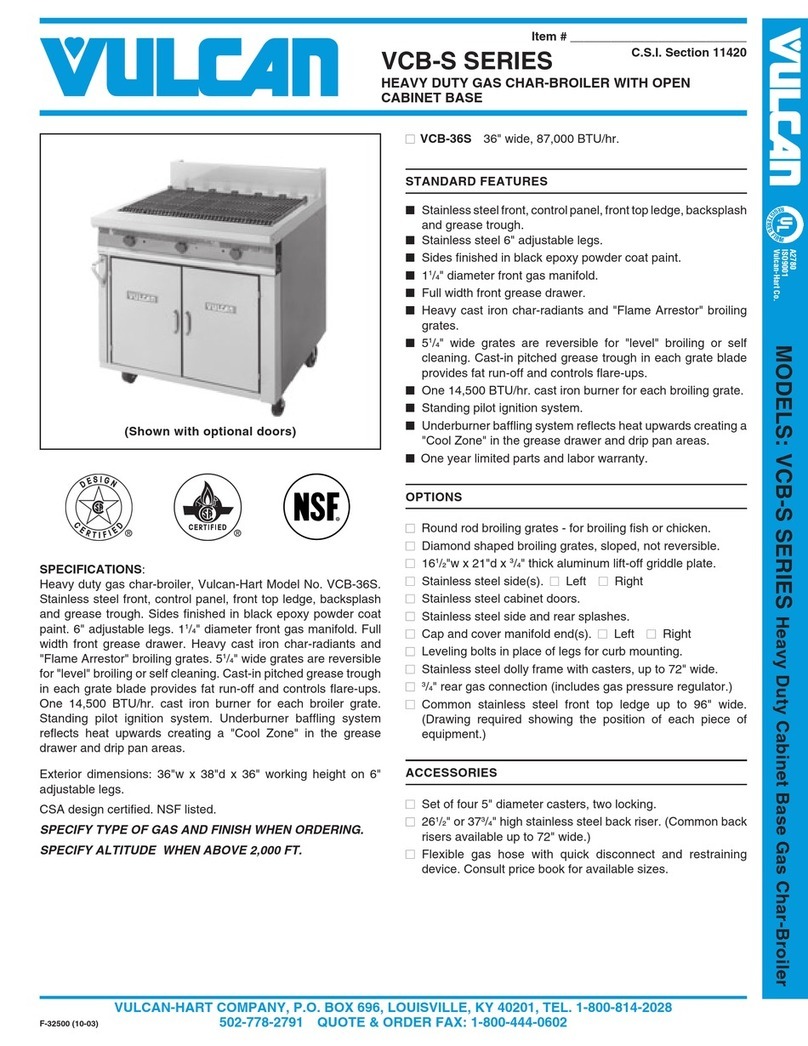
Vulcan-Hart
Vulcan-Hart VCB-S User manual

Vulcan-Hart
Vulcan-Hart Vulcan VCCB25 User manual

Vulcan-Hart
Vulcan-Hart VACB20 User manual
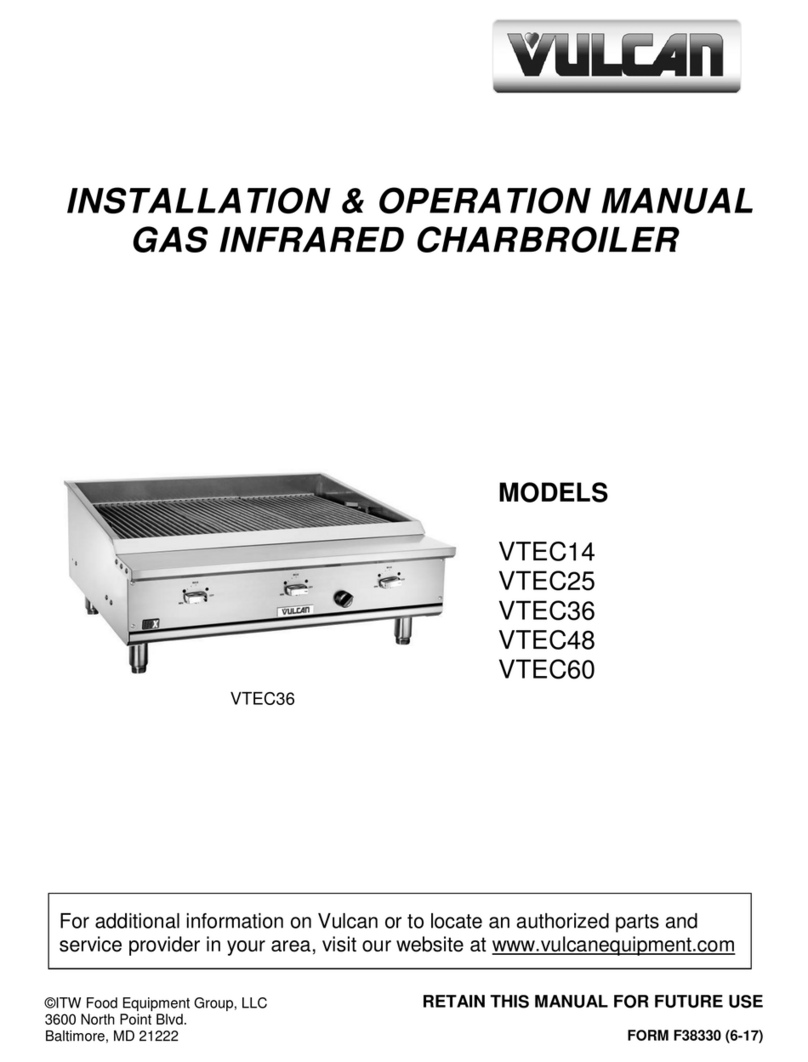
Vulcan-Hart
Vulcan-Hart VTEC14 User manual
